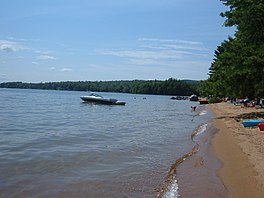| Sebago Lake | |
|---|---|
 A beach in Sebago Lake State Park | |
| Location | Cumberland County, Maine |
| Coordinates | 43°51′N 70°34′W / 43.850°N 70.567°W |
| Lake type | oligotrophic |
| Primary outflows | Presumpscot River |
| Catchment area | 440 square miles (1,100 km2)[1] |
| Basin countries | United States |
| Max. length | 12 mi (19 km) |
| Surface area | 30,513 acres (12,348 ha)[1] |
| Average depth | 107 ft (33 m)[1] |
| Max. depth | 316 ft (96 m)[1] |
| Water volume | 3,224,233 acre⋅ft (3.977033×109 m3)[1] |
| Residence time | 5.1 to 5.4 yrs |
| Shore length1 | 105 miles (169 km)[2] |
| Surface elevation | 267 ft (81 m)[1] |
| Islands | Frye Island |
| Settlements | Casco, Naples, Raymond, Sebago, Standish and Windham |
| References | [1] |
| 1 Shore length is not a well-defined measure. | |

Sebago Lake (Sih-Bay-Goh) is the deepest and second-largest lake in the U.S. state of Maine. The lake is 316 feet (96 m) deep at its deepest point, with a mean depth of 101 feet (31 m). It is possible that Sebago is the deepest lake wholly contained within the entire New England region, although some sources say that Vermont's Lake Willoughby is slightly deeper. Along with Lake Champlain, Sebago is one of the only lakes in the area that does not consistently freeze solid during the winter months, with total ice cover only occurring for a short period of time every few winters. Sebago covers about 45 square miles (117 km2) in surface area, has a length of 14 miles (23 km) and has a shoreline length of roughly 105 miles (169 km).[2] The surface is around 270 feet (82 m) above sea level, so the deep bottom is below the present sea level.[3] It is in Cumberland County, and bordered by the towns of Casco, Naples, Raymond, Sebago, Standish and Windham. The seasonally occupied town of Frye Island is on an island in the lake. Sebago Lake and the surrounding area is known for its erratic and sudden changes in weather during all seasons, likely due to its proximity to the Atlantic Ocean and to Mt. Washington, a very notorious extreme weather hotspot. The name comes from the Abenaki sobagoo, meaning "it is the sea" or "it resembles the sea".[4]
- ^ a b c d e f g Maine Depts. of Environmental Protection and Inland Fisheries & Wildlife. "Maine Lakes: Morphometry and Geographic Information". Senator George J. Mitchell Center for Environmental and Watershed Research, The University of Maine. Archived from the original on 2011-07-19. Retrieved July 31, 2008.
- ^ a b "Sebago Lake". Portland Water District, Portland Maine. Retrieved May 5, 2006.
- ^ "Why is Sebago Lake so deep?". Maine Geological Survey, Department of Conservation, State of Maine. Retrieved 2017-12-22.
- ^ Laurent, Joseph (1884). New Familiar Abenakis and English Dialogues.
© MMXXIII Rich X Search. We shall prevail. All rights reserved. Rich X Search


